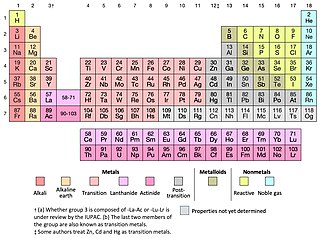
The alkali metals consist of the chemical elements lithium (Li), sodium (Na), potassium (K), rubidium (Rb), caesium (Cs), and francium (Fr). Together with hydrogen they constitute group 1, which lies in the s-block of the periodic table. All alkali metals have their outermost electron in an s-orbital: this shared electron configuration results in their having very similar characteristic properties. Indeed, the alkali metals provide the best example of group trends in properties in the periodic table, with elements exhibiting well-characterised homologous behaviour. This family of elements is also known as the lithium family after its leading element.

Aluminium is a chemical element with the symbol Al and atomic number 13. It is a silvery-white, soft, non-magnetic and ductile metal in the boron group. By mass, aluminium is the most abundant metal in the Earth's crust and the third most abundant element. The abundance of aluminium decreases relative to other elements at greater depths into Earth's mantle and beyond. The chief ore of aluminium is bauxite. Aluminium metal is highly reactive, so native specimens are rare and limited to extreme reducing environments. Instead, it is found combined in over 270 different minerals.

An alloy is a combination of metals or metals combined with one or more other elements. For example, combining the metallic elements gold and copper produces red gold, gold and silver becomes white gold, and silver combined with copper produces sterling silver. Elemental iron, combined with non-metallic carbon or silicon, produces alloys called steel or silicon steel. The resulting mixture forms a substance with properties that often differ from those of the pure metals, such as increased strength or hardness. Unlike other substances that may contain metallic bases but do not behave as metals, such as aluminium oxide (sapphire), beryllium aluminium silicate (emerald) or sodium chloride (salt), an alloy will retain all the properties of a metal in the resulting material, such as electrical conductivity, ductility, opaqueness, and luster. Alloys are used in a wide variety of applications, from the steel alloys, used in everything from buildings to automobiles to surgical tools, to exotic titanium-alloys used in the aerospace industry, to beryllium-copper alloys for non-sparking tools. In some cases, a combination of metals may reduce the overall cost of the material while preserving important properties. In other cases, the combination of metals imparts synergistic properties to the constituent metal elements such as corrosion resistance or mechanical strength. Examples of alloys are steel, solder, brass, pewter, duralumin, bronze and amalgams.
Black metal is an extreme subgenre of heavy metal music. Common traits include fast tempos, a shrieking vocal style, heavily distorted guitars played with tremolo picking, raw (lo-fi) recording, unconventional song structures, and an emphasis on atmosphere. Artists often appear in corpse paint and adopt pseudonyms.
Death metal is an extreme subgenre of heavy metal music. It typically employs heavily distorted and low-tuned guitars, played with techniques such as palm muting and tremolo picking, deep growling vocals, aggressive, powerful drumming featuring double kick and blast beat techniques, minor keys or atonality, abrupt tempo, key, and time signature changes, and chromatic chord progressions. The lyrical themes of death metal may include slasher film-style violence, political conflict, religion, nature, philosophy, and science fiction.
Heavy metal is a genre of rock music that developed in the late 1960s and early 1970s, largely in the United Kingdom and to a lesser extent in the United States. With roots in blues rock, psychedelic rock, and acid rock, heavy metal bands developed a thick, massive sound, characterized by distortion, extended guitar solos, emphatic beats, and loudness. The lyrics and performances are sometimes associated with aggression and machismo.

A metal is a material that, when freshly prepared, polished, or fractured, shows a lustrous appearance, and conducts electricity and heat relatively well. Metals are typically malleable or ductile. A metal may be a chemical element such as iron; an alloy such as stainless steel; or a molecular compound such as polymeric sulfur nitride.

Metallurgy is a domain of materials science and engineering that studies the physical and chemical behavior of metallic elements, their inter-metallic compounds, and their mixtures, which are called alloys. Metallurgy encompasses both the science and the technology of metals. That is, the way in which science is applied to the production of metals, and the engineering of metal components used in products for both consumers and manufacturers. Metallurgy is distinct from the craft of metalworking. Metalworking relies on metallurgy in a similar manner to how medicine relies on medical science for technical advancement. A specialist practitioner of metallurgy is known as a Metallurgist.
Nu metal is a subgenre of alternative metal that combines elements of heavy metal music with elements of other music genres such as hip hop, alternative rock, funk, industrial, and grunge. Nu metal bands have drawn elements and influences from a variety of musical styles, including multiple genres of heavy metal. Nu metal rarely features guitar solos or other displays of technical competence; the genre is heavily syncopated and based on guitar riffs. Many nu metal guitarists use seven-string guitars that are down-tuned to play a heavier sound. DJs are occasionally featured in nu metal to provide instrumentation such as sampling, turntable scratching and electronic backgrounds. Vocal styles in nu metal include singing, rapping, screaming and growling. Nu metal is one of the key genres of the new wave of American heavy metal.

The periodic table, also known as the periodic table of elements, is a tabular display of the chemical elements, which are arranged by atomic number, electron configuration, and recurring chemical properties. The structure of the table shows periodic trends. The seven rows of the table, called periods, generally have metals on the left and nonmetals on the right. The columns, called groups, contain elements with similar chemical behaviours. Six groups have accepted names as well as assigned numbers: for example, group 17 elements are the halogens; and group 18 are the noble gases. Also displayed are four simple rectangular areas or blocks associated with the filling of different atomic orbitals.
In chemistry, the term transition metal has three possible definitions:
Progressive metal is a broad fusion music genre melding heavy metal and progressive rock, combining the loud "aggression" and amplified guitar-driven sound of the former with the more experimental, cerebral or "pseudo-classical" compositions of the latter. One of these experimental examples introduced to modern metal was djent. The music typically showcases the extreme technical proficiency of the performers and usually uses unorthodox harmonies as well as complex rhythms with frequent meter changes and intense syncopation.
Thrash metal is an extreme subgenre of heavy metal music characterized by its overall aggression and often fast tempo. The songs usually use fast percussive beats and low-register guitar riffs, overlaid with shredding-style lead guitar work. The lyrical subject matter often deals with criticisms of The Establishment and concern over the destruction of the environment, and at times shares a disdain for Christian dogma resembling that of their black metal counterparts. The language is typically quite direct and denunciatory, an approach borrowed from hardcore punk.

Pantera was an American heavy metal band from Arlington, Texas, formed in 1981. The group's best-known lineup consisted of the Abbott brothers—drummer Vinnie Paul and guitarist Dimebag Darrell—along with vocalist Phil Anselmo and bassist Rex Brown. In addition to their development and popularization of the groove metal subgenre, Pantera is credited for being part of the second wave of thrash metal scene from the late 1980s to early-to-mid 1990s. Pantera is regarded as one of the most successful and influential bands in heavy metal history, having sold around 40 million records worldwide, and being nominated four times at the Grammy's.

Iron Maiden are an English heavy metal band formed in Leyton, East London, in 1975 by bassist and primary songwriter Steve Harris. The band's discography has grown to 40 albums, including 16 studio albums, 13 live albums, four EPs, and seven compilations.
Doom metal is an extreme subgenre of heavy metal music that typically uses slower tempos, low-tuned guitars and a much "thicker" or "heavier" sound than other heavy metal genres. Both the music and the lyrics intend to evoke a sense of despair, dread, and impending doom. The genre is strongly influenced by the early work of Black Sabbath, who formed a prototype for doom metal. During the first half of the 1980s, a number of bands from England, the United States and Sweden defined doom metal as a distinct genre.
Glam metal, also known as hair metal or pop metal, is a subgenre of heavy metal, which features pop-influenced hooks and guitar riffs, and borrows heavily from the fashion and image of 1970s glam rock.
Power metal is a subgenre of heavy metal combining characteristics of traditional heavy metal with speed metal, often within symphonic context. Generally, power metal is characterized by a faster, lighter, and more uplifting sound, in contrast with the heaviness and dissonance prevalent, for example, in extreme metal. Power metal bands usually have anthem-like songs with fantasy-based subject matter and strong choruses, thus creating a theatrical, dramatic and emotionally "powerful" sound.
Alternative metal is a rock music fusion genre that infuses heavy metal with influences from alternative rock and other genres not normally associated with metal. Alternative metal bands are often characterized by heavily downtuned, mid-paced guitar riffs, a mixture of accessible melodic vocals and harsh vocals and sometimes unconventional sounds within other heavy metal styles. The term has been in use since the 1980s, although it came into prominence in the 1990s.

Metal Gear is a series of action-adventure stealth video games created by Hideo Kojima and developed and published by Konami. The first game, Metal Gear, was released in 1987 for MSX home computers. The player often takes control of a special forces operative, who is assigned the task of finding the titular superweapon "Metal Gear", a bipedal walking tank with the ability to launch nuclear weapons.